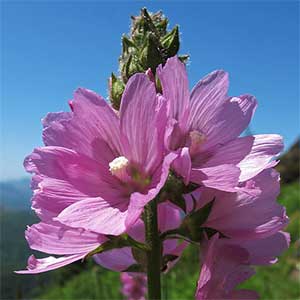Sidalcea hartwegii
Sidalcea hirtipes
Hartweg's checkerbloom, valley checkerbloom
bluff mallow, bristly-stem checker-mallow, bristly-stem checkerbloom, hairy-stem checkermallow
single, erect, unbranched or distally branched, often zigzag, solid, proximally usually glabrous or sparsely stellate-puberulent.
several, scattered, erect, arising from rhizome apices, usually slightly hollow, densely, harshly bristly-hirsute, hairs stiff, pustular, simple, forked, or stellate, often 2–2.5 mm.
cauline;
stipules deciduous or inconspicuous, sometimes purplish, subulate, 1–1.5(–3) × 0.5–1 mm;
petiole 0.5–1.5(–3) cm, usually 1/2 times involucellar bractlets absent.
basal and cauline;
stipules linear-subulate, 6–8 × 1–1.5 mm;
petioles of proximal leaves 20–30 cm, 3 times as long as blades, reduced distally to 1/2 times as long as blades;
blades: basal and proximalmost orbiculate to reniform, shallowly 5–9-lobed, 10–15 × 10–15 cm, thick, base narrowly cordate, lobe margins coarsely crenate-dentate, apex rounded, surfaces coarsely hirsute, hairs stiff;
distal orbiculate, deeply palmately 5–7-lobed, incised ± to base, lobes sometimes lobed again, base cuneate, apex acute, deeply 2–3-toothed, surfaces long-hirsute or with 2–4-rayed, stellate hairs abaxially.
erect, spiciform to subcapitate, dense, calyces usually conspicuously overlapping in flower and sometimes in fruit, proximals usually long-pedunculate, unbranched or branched, 20+-flowered, 10+ flowers usually open on spike at same time, not interrupted, not 1-sided, usually to 8 cm, usually not elongate but sometimes slightly elongated in some populations and to 20 cm in fruit;
bracts paired or single, linear, distal undivided, proximal distinct to base, 6 mm, mostly slightly longer than pedicels.
1–3(–5) mm;
involucellar bractlets absent.
bisexual or unisexual and pistillate, plants gynodioecious;
calyx 8–10(–12) mm, not much enlarging in fruit, stellate-canescent, sparsely ciliate;
petals pink to rose-purple or white, pale-veined, often whitened at base, 18–20(–25) mm;
stamens: outer filaments incompletely connate, distally distinct, anthers not attached to connate portion of filaments;
staminal column 6–7 mm, hairy;
anthers white, stalked, aborted in pistillate flowers;
stigmas 6 or 7.
bisexual or unisexual and pistillate, plants gynodioecious;
calyx often purple tinted, 9–11 mm, to 11–16 mm in fruit, margins ciliate, hairs 1–2 mm, surfaces finely stellate-hairy at base and with coarser, longer, simple and stellate hairs apically;
petals usually pale pink to rose-lavender, rarely white, slightly or not pale-veined, (9–)10–21 mm, pistillate often 9–14 mm;
staminal column 5–7(–10) mm, hairy;
anthers white;
stigmas 5–10.
1.5–2 mm.
2.5–3.5 mm.
5–7 mm diam.;
mericarps 6 or 7, 2.5–4 mm, sides smooth, margins rugose, back reticulate-veined, deeply pitted especially on top, glabrous or glandular-puberulent, mucro 0.5–0.8(–1) mm.
7–8 mm diam.;
mericarps 5–10, 3.5–4 mm, glabrous or sparsely stellate-puberulent, roughened, prominently reticulate-veined, sides rugose and pitted, back less so, mucro 0.6–0.8 mm.
= 60.
Sidalcea hartwegii
Sidalcea hirtipes
Sidalcea hartwegii is widespread in California from Tulare to Shasta counties, a range similar to those of the other vernal-pool annuals. It is most easily recognized by its stamen column, on which the anthers are borne on free portions of filaments, unlike in the other annual
species and more typical of the perennial species. This helps to support the suggestion that the annual species were separately derived and not part of a single lineage. Sidalcea hartwegii often grows with S. calycosa, from which it can be distinguished also by its rugose rather than deeply longitudinally furrowed dorsal mericarp surfaces.
(Discussion copyrighted by Flora of North America; reprinted with permission.)
Of conservation concern.
Sidalcea hirtipes is uncommon and known from Clatsop, Lincoln, and Tillamook counties in Oregon and Clark, Lewis, and Wahkiakum counties in Washington. Its elevation and habitat vary, and it seems as much at home on steep coastal cliffs as in more inland, historic prairies and mountain meadows. Populations can appear to be large because of the long-rhizomatous and clonal nature of the plants; they are few and local. It is threatened by grazing, loss of habitat, fire suppression, road construction and maintenance, and changes in hydrology. It is a candidate for listing in Oregon and has been listed as endangered in Washington. Sidalcea hirtipes is characterized by its coarse indument of bristle hairs, its generally compact spikelike inflorescences, its relatively few, large, erect, hirsute leaves, and, especially, its extensive, coarse rhizomes. The inflorescences in some populations are elongated in fruit; its range, hirsute indument, and thick leaves along with coarse rhizomes help to distinguish it from other species. Stem internode length varies depending on habitat, as in many other Sidalcea. Molecular data suggest a relationship among S. hirtipes and S. asprella, S. celata, and S. gigantea (K. Andreasen and B. G. Baldwin 2003).
(Discussion copyrighted by Flora of North America; reprinted with permission.)
